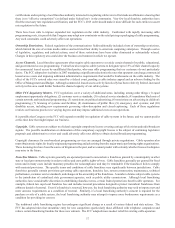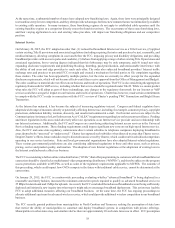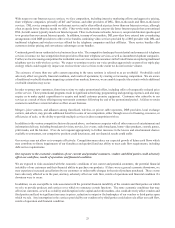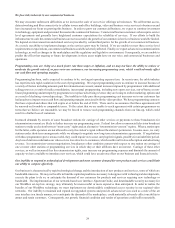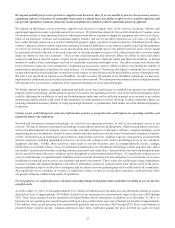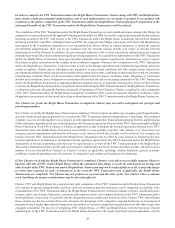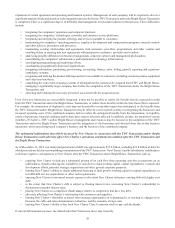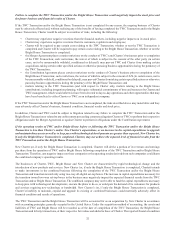Charter 2015 Annual Report Download - page 40
Download and view the complete annual report
Please find page 40 of the 2015 Charter annual report below. You can navigate through the pages in the report by either clicking on the pages listed below, or by using the keyword search tool below to find specific information within the annual report.25
We depend on third party service providers, suppliers and licensors; thus, if we are unable to procure the necessary services,
equipment, software or licenses on reasonable terms and on a timely basis, our ability to offer services could be impaired, and
our growth, operations, business, financial results and financial condition could be materially adversely affected.
We depend on third party service providers, suppliers and licensors to supply some of the services, hardware, software and
operational support necessary to provide some of our services. We obtain these materials from a limited number of vendors, some
of which do not have a long operating history or which may not be able to continue to supply the equipment and services we desire.
Some of our hardware, software and operational support vendors, and service providers represent our sole source of supply or
have, either through contract or as a result of intellectual property rights, a position of some exclusivity. If demand exceeds these
vendors’ capacity or if these vendors experience operating or financial difficulties, or are otherwise unable to provide the equipment
or services we need in a timely manner, at our specifications and at reasonable prices, our ability to provide some services might
be materially adversely affected, or the need to procure or develop alternative sources of the affected materials or services might
delay our ability to serve our customers. These events could materially and adversely affect our ability to retain and attract
customers, and have a material negative impact on our operations, business, financial results and financial condition. A limited
number of vendors of key technologies can lead to less product innovation and higher costs. Our cable systems have historically
been restricted to using one of two proprietary conditional access security systems, which we believe has limited the number of
manufacturers producing set-top boxes for such systems. As an alternative, Charter has developed a conditional access security
system which may be downloaded into set-top boxes with features we specify that could be provided by a variety of manufacturers.
We refer to our specified set-top box as our Worldbox. In order to realize the benefits of our Worldbox technology, we must now
implement the conditional access security system across our video network. We cannot provide assurances that this implementation
will ultimately be successful or completed in the expected timeframe or at the expected budget.
We further depend on patent, copyright, trademark and trade secret laws and licenses to establish and maintain our intellectual
property rights in technology and the products and services used in our operating activities. Any of our intellectual property rights
could be challenged or invalidated, or such intellectual property rights may not be sufficient to permit us to continue to use certain
intellectual property, which could result in discontinuance of certain product or service offerings or other competitive harm, our
incurring substantial monetary liability or being enjoined preliminarily or permanently from further use of the intellectual property
in question.
Various events could disrupt our networks, information systems or properties and could impair our operating activities and
negatively impact our reputation.
Network and information systems technologies are critical to our operating activities, as well as our customers' access to our
services. We may be subject to information technology system failures and network disruptions. Malicious and abusive activities,
such as the dissemination of computer viruses, worms, and other destructive or disruptive software, computer hackings, social
engineering, process breakdowns, denial of service attacks and other malicious activities have become more common in industry
overall. If directed at us or technologies upon which we depend, these activities could have adverse consequences on our network
and our customers, including degradation of service, excessive call volume to call centers, and damage to our or our customers'
equipment and data. Further, these activities could result in security breaches, such as misappropriation, misuse, leakage,
falsification or accidental release or loss of information maintained in our information technology systems and networks, and in
our vendors’ systems and networks, including customer, personnel and vendor data. System failures and network disruptions may
also be caused by natural disasters, accidents, power disruptions or telecommunications failures. If a significant incident were to
occur, it could damage our reputation and credibility, lead to customer dissatisfaction and, ultimately, loss of customers or revenue,
in addition to increased costs to service our customers and protect our network. These events also could result in large expenditures
to repair or replace the damaged properties, networks or information systems or to protect them from similar events in the future.
System redundancy may be ineffective or inadequate, and our disaster recovery planning may not be sufficient for all eventualities.
Any significant loss of customers or revenue, or significant increase in costs of serving those customers, could adversely affect
our growth, financial condition and results of operations.
For tax purposes, we could experience a deemed ownership change in the future that could limit our ability to use our tax loss
carryforwards.
As of December 31, 2015, we had approximately $11.3 billion of federal tax net operating loss carryforwards resulting in a gross
deferred tax asset of approximately $4.0 billion. Federal tax net operating loss carryforwards expire in the years 2020 through
2035. These losses resulted from the operations of Charter Holdco and its subsidiaries. In addition, as of December 31, 2015, we
had state tax net operating loss carryforwards resulting in a gross deferred tax asset (net of federal tax benefit) of approximately
$365 million. State tax net operating loss carryforwards generally expire in the years 2016 through 2035. Due to uncertainties in
projected future taxable income, valuation allowances have been established against the gross deferred tax assets for book




